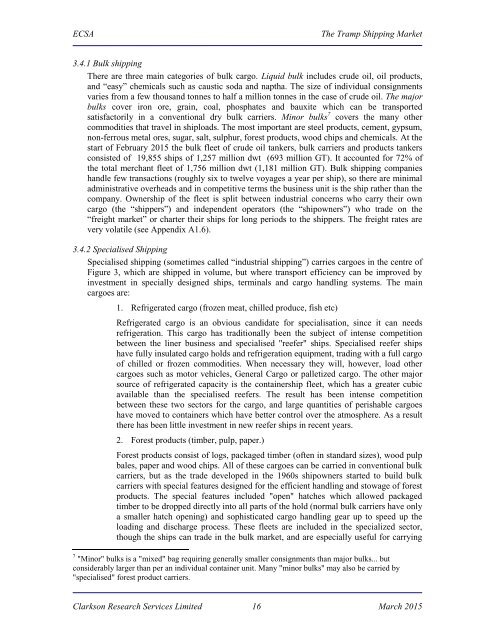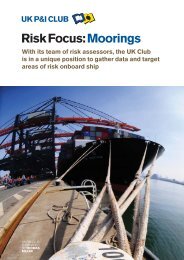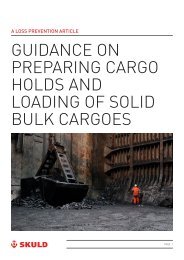You also want an ePaper? Increase the reach of your titles
YUMPU automatically turns print PDFs into web optimized ePapers that Google loves.
<strong>ECSA</strong><br />
<strong>The</strong> <strong>Tramp</strong> <strong>Shipping</strong> <strong><strong>Mar</strong>ket</strong><br />
3.4.1 Bulk shipping<br />
<strong>The</strong>re are three main categories of bulk cargo. Liquid bulk includes crude oil, oil products,<br />
and “easy” chemicals such as caustic soda and naptha. <strong>The</strong> size of individual consignments<br />
varies from a few thousand tonnes to half a million tonnes in the case of crude oil. <strong>The</strong> major<br />
bulks cover iron ore, grain, coal, phosphates and bauxite which can be transported<br />
satisfactorily in a conventional dry bulk carriers. Minor bulks 7 covers the many other<br />
commodities that travel in shiploads. <strong>The</strong> most important are steel products, cement, gypsum,<br />
non-ferrous metal ores, sugar, salt, sulphur, forest products, wood chips and chemicals. At the<br />
start of February <strong>2015</strong> the bulk fleet of crude oil tankers, bulk carriers and products tankers<br />
consisted of 19,855 ships of 1,257 million dwt (693 million GT). It accounted for 72% of<br />
the total merchant fleet of 1,756 million dwt (1,181 million GT). Bulk shipping companies<br />
handle few transactions (roughly six to twelve voyages a year per ship), so there are minimal<br />
administrative overheads and in competitive terms the business unit is the ship rather than the<br />
company. Ownership of the fleet is split between industrial concerns who carry their own<br />
cargo (the “shippers”) and independent operators (the “shipowners”) who trade on the<br />
“freight market” or charter their ships for long periods to the shippers. <strong>The</strong> freight rates are<br />
very volatile (see Appendix A1.6).<br />
3.4.2 Specialised <strong>Shipping</strong><br />
Specialised shipping (sometimes called “industrial shipping”) carries cargoes in the centre of<br />
Figure 3, which are shipped in volume, but where transport efficiency can be improved by<br />
investment in specially designed ships, terminals and cargo handling systems. <strong>The</strong> main<br />
cargoes are:<br />
1. Refrigerated cargo (frozen meat, chilled produce, fish etc)<br />
Refrigerated cargo is an obvious candidate for specialisation, since it can needs<br />
refrigeration. This cargo has traditionally been the subject of intense competition<br />
between the liner business and specialised "reefer" ships. Specialised reefer ships<br />
have fully insulated cargo holds and refrigeration equipment, trading with a full cargo<br />
of chilled or frozen commodities. When necessary they will, however, load other<br />
cargoes such as motor vehicles, General Cargo or palletized cargo. <strong>The</strong> other major<br />
source of refrigerated capacity is the containership fleet, which has a greater cubic<br />
available than the specialised reefers. <strong>The</strong> result has been intense competition<br />
between these two sectors for the cargo, and large quantities of perishable cargoes<br />
have moved to containers which have better control over the atmosphere. As a result<br />
there has been little investment in new reefer ships in recent years.<br />
2. Forest products (timber, pulp, paper.)<br />
Forest products consist of logs, packaged timber (often in standard sizes), wood pulp<br />
bales, paper and wood chips. All of these cargoes can be carried in conventional bulk<br />
carriers, but as the trade developed in the 1960s shipowners started to build bulk<br />
carriers with special features designed for the efficient handling and stowage of forest<br />
products. <strong>The</strong> special features included "open" hatches which allowed packaged<br />
timber to be dropped directly into all parts of the hold (normal bulk carriers have only<br />
a smaller hatch opening) and sophisticated cargo handling gear up to speed up the<br />
loading and discharge process. <strong>The</strong>se fleets are included in the specialized sector,<br />
though the ships can trade in the bulk market, and are especially useful for carrying<br />
7 "Minor" bulks is a "mixed" bag requiring generally smaller consignments than major bulks... but<br />
considerably larger than per an individual container unit. Many "minor bulks" may also be carried by<br />
"specialised" forest product carriers.<br />
Clarkson Research Services Limited 16 <strong>Mar</strong>ch <strong>2015</strong>




